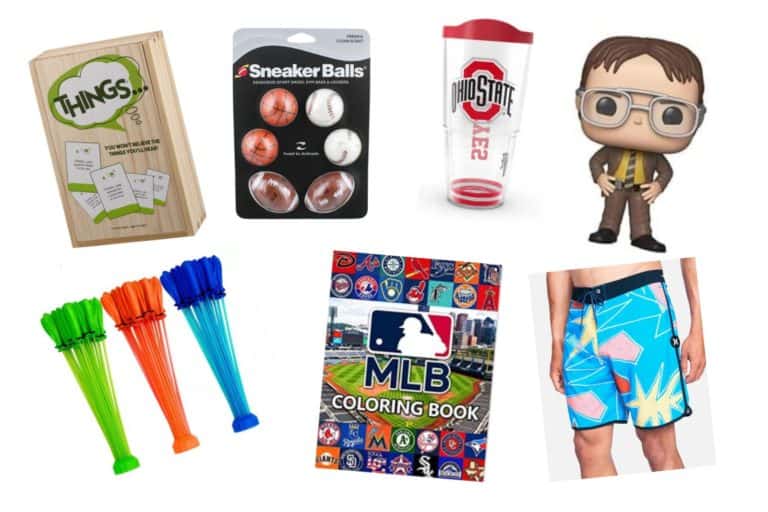How to Help Your Tweens & Teens Make the Best of School This Fall

For many tweens and teens, back to school will look different this year – in ways that could cause a lot of disappointment and anxiety. As parents, were trying to guide our kids through this challenging and ever-changing time in the midst of our own stress. There are things we can and should do to help our kids. We looked to experts in adolescence to share how we can help our tweens and teens make the best of this school year in ways that can flex as the situation changes.
This post contains some affiliate links – we earn a small commission if you purchase through our links, and we appreciate your support.
I knew my kids’ school district planned to release the plan for fall this week. The official notification popped into my email inbox today.
Just seeing the subject line gave me a spark of anxiety: Schools Responsible Restart Plan. Before I had a chance to even review it, my phone lit up with texts. “Have you seen the plan?” followed by lots of comments…
- “I’m going to see so many tears when I share this plan with my kids”
- “It’s really hard to think about our kids wearing masks all day”
- “I’m worried we’re doing all of these things to be cautious and our kids will still get sick”
- “My daughter was already stressed about starting middle school and now she won’t have some of her closest friends there for support”
And my personal favorite:
- “We grew tiny humans and birthed them. We can beat COVID craziness!”
Though different schools have different plans – and all of the plans are subject to change – we’re still in the hot seat as parents to help our tweens and teens process what we think school will look like this fall. (Heck, we’re trying to figure out how to process it ourselves so we CAN help our kids.)
The plan for my kids’ school is a hybrid format where kids with last names starting with A-K go to school Mondays, Wednesdays and every other Friday. Kids with last names L-Z go Tuesdays, Thursdays and the other Fridays. Yes, masks are required. No, it doesn’t seem that there will be organized online coordination or a teacher presence on the days my kids are home because their teachers will be teaching other students in person on those days.
It’s my oldest son’s first year of junior high this year. The ABC name split means that the majority of his close buddies will go to school on opposite days – so he’ll be home when they’re at school and vice versa. There’s a good chance school sports and activities won’t happen, at least for fall. Our family may also need our 13-year-old to be part of a cobbled together childcare plan on days he doesn’t have school when my husband and I can’t work from home.
COVID definitely piles some extra “blech” on to the already-awkward and stressful start of junior high. I guess big bangs and pegged jeans aren’t actually the worst way to spend middle school.
Kristie has two middle school sons that attend different schools. Welcome to two different and ever-shifting plans – and the trickle down impact on the kids’ needs for transportation, schoolwork oversight, and any other number of things.
A good friend of mine’s oldest son will be a high school senior. So far, things in our area are not shaping up for the senior year he was hoping to have as a student athlete. Memorable, yes. Ideal, no.
So let me just get this out of the way. All signs point to school being kind of sucky for many of our kids and us this school year due to COVID. Whether it’s not seeing certain friends, stuffy masks, new restrictions at school, canceled or altered sports or activities or childcare concerns with kids suddenly not at school every day…the most for-sure thing we know is that this school year will look different. And we’re going to feel frustrated. And sad. And disappointed. And it’s reasonable and ok to feel that way.
We also have a responsibility as parents to guide our kids through this challenging time. It’s tricky to know how to do that since we’re in uncharted territory in a lot of ways, but there are things we can and should do as parents regardless of how this school year plays out. We looked to experts in adolescence to share how to help our tweens and teens make the best of this school year in ways that can flex as the situation changes.
1. Keep Calm and Parent On
I listened to a podcast on Developing Family Resilience During Challenging Times featuring the co-directors of The Resilience Project Parents Program, a community outreach program based out of Newton-Wellesley Hospital.
As a communication professor, my ears perked up when they mentioned the 4 Cs of Communication as a way to have better conversations with our tweens and teens: Calm, Curious, Compassionate and Concerned.
What struck me the most was the emphasis on walking through the 4 Cs IN ORDER. The process needs to start with CALM, which means timing conversations for times when we’re calm.
I would not characterize my attitude in the hour directly after learning my school’s plan for this fall as calm. My emotions bounced all around as I processed with my husband and close friends. On one hand, I was anxious to share the news with my kids. I wanted to be sure they heard it from me first before their own texts started flowing in. But I decided to wait until I had talked to my husband, calmed down and formed a strategy we felt good about (jump down to the list below for ways to create that strategy) before I shared the school’s plan with my kids.
I do have questions, concerns and fears about what back to school will look like, and there will be times I share those in moderation with my kids. Transparency is important. But I also want to be thoughtful before I share things and make sure I’m intentional and not reactive. That means waiting for the right (calm) time.
2. Listen to Learn, and Learn to Listen
The second C in the process of communicating well with our tweens and teens is CURIOUS, which means listening. The experts threw out the quip “listening to learn and learning to listen.”
Active listening takes more time and effort than we’re often willing to put in. There are things we can do to become better listeners. A good way to start is to learn about the different listening styles. Knowing your own listening style and where your kids fall can help your kids feel like you’re really listening to what they’re sharing.
3. Give Kids Time & Space to Feel the Feels
The final steps: be COMPASSIONATE and then share your CONCERNS. The TiLT Parenting podcast featured Dr. Christine Carter on an episode about supporting our adolescents during a global pandemic. Carter is the author of The New Adolescence, Raising Happy & Successful Teens in an Age of Anxiety and Distraction.
I’m really interested in reading this book based on the podcast. Carter has four teenagers and self-reports herself as a bossy person who’s learning when to let go. She dropped some great advice, and I’m saving some of it for an upcoming post on getting tech under control with our tweens and teens.
Specific to the pandemic, Carter emphasizes that as parents we need to acknowledge that our tweens and teens are suffering losses – tell them it’s ok to be sad and grieve these losses.
“Mental health is about having appropriate emotions when it makes sense to have them. It’s not about being happy all the time.”
It makes total sense that our kids are feeling angry, sad, frustrated or scared during this pandemic…and about the fact that, gosh darn it, it’s STILL affecting our lives this fall?! As parents, we can help our kids know that it’s ok to have these feelings and then consider healthy ways to process those emotions and move forward.
It goes against my every instinct to listen first and talk after, but that’s what I need to do to help my middle schooler. After we listen and show empathy, then it’s our turn as parents to voice our own perspectives and concerns. Reversing the order can lead to our kids shutting down before the conversation really gets going.
I might need to order this from Etsy to put on my desk. Or maybe I should consider something more permanent, like a tattoo.
If your tween or teen likes to process by writing things down, consider ordering The Big Life Journal for Teens. It has interesting prompts and encourages tweens and teens to think and talk about some of the top issues that cause anxiety.
4. Show Kids There’s a Payoff for the Pandemic
One big way to move your tweens or teens toward the acceptance phase in disappointments about back-to-school changes is to encourage them to look for the good and assure them it exists. Dr. Carter says to clearly tell kids there’s going to be a payoff through this pandemic and that they’re going to be able to handle change in the things life throws at them better than previous generations.
The capacity to adapt is the definition of resilience. This pandemic is helping us raise resilient kids. The co-directors of The Resilience Project Parents Program compare the skill of resilience to a muscle that can be built – over time and with “micro interactions” that happen throughout days, weeks or months.
It’s hard to see our kids disappointed or hurting, but it’s also an opportunity to teach tiny lessons in adapting.
A friend of mine shared this on Facebook and it cut through all of my emotional clutter on what school may look like this fall as an important reminder.
We wrote more about the best way to raise resilient kids in an anxious generation, but I’ll still make an important plug here for fostering gratitude as a top way to help kids cope. We also pulled together a list of fun ways to teach your kids gratitude to give you some new ideas.
Print out this free gratitude photo scavenger hunt as fun way to remind tweens and teens to appreciate all they have.
5. Foster Connections as a Coping Mechanism
Another important lesson in resilience we can teach our kids is the power of human connection (isn’t that ironic during a year where most of us have been more physically isolated than ever before).
A Cigna study found that GenZ is now the loneliest generation. Researchers point to a variety of reasons, including social media use, but the bottom line is that loneliness leads to poor physical and mental health. With the pandemic limiting in-person interactions, we need to teach our kids why friendships and relationships are so important and help them make and be good friends.
We haven’t written specifically about helping our kids make and sustain solid friendships (putting it on my list), but a lot of what we share in our post on why moms should make more time for friendships can translate directly into lessons for our tweens and teens.
I’ll never forget the day my son got a phone call from a good friend that he’d been in a car accident. I was in the room and could tell something was wrong. I realized pretty quickly that his friend was calling from the scene of the accident. Everyone was ok, but my son’s friend was shaken up. I was so glad he called, and I was thankful for a friendship between my son and another 12-year-old boy that meant they would call each other when times were tough. They’re building the kind of friendship where they can console and share with each other, and my son will need that to thrive not only in middle and high school, but in life.
I’m reading an advance copy of Shasta Nelson’s new book The Business of Friendship, and she brings up the three pillars of authentic friendship: positivity, vulnerability and consistency. Even in the midst of a pandemic, we can find ways as parents to help our kids find consistent ways to connect with core friends – whether it’s in person, via text or even on Playstation or Marco Polo. We can encourage our kids to ask real questions and share feelings with trusted friends. And we can coach our kids that friendships built to last should leave you and your friends feeling good about yourselves.
If you and your kids are grappling with anxiety over what back to school will look like for fall, know that you’re not alone. There are thing we can do to help our kids cope and continue building in them a resiliency that will serve them the rest of their lives. Some days we’ll nail it, and other days we’ll fail it. But let’s keep trying!
We’d love to hear how you’re feeling about back to school. Let us know in the comments or email us at support@salteffect.com.
















